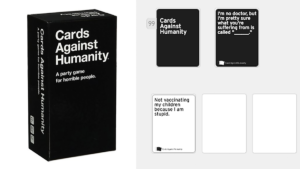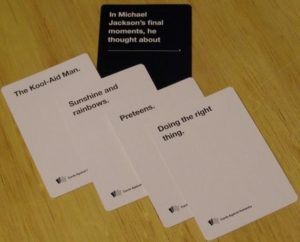
Cards Against Humanity is an adults-only game for players mature enough to handle the provocative (but often hilarious) topics and answers.
The goal is to pair the answer and question cards in the funniest, most provocative or cleverest way.
Players
At least 4 players but most fun with 6-8 players, and it could even get to 20+ players
Gameplay
To start the game, each player draws ten white cards.
According to the rule book provided with the game, the person who most recently defecated (a form of primitive randomization) begins as the “Card Czar” (or “Card Tsar”) and plays a black card, face up. The Card Czar then reads the question or fill-in-the-blanks phrase on the black card out loud.
The other players answer the question or fill in the blanks by each passing one white card (or however many required by the black card), face down, to the Card Czar.
The Card Czar shuffles all of the answers and shares each card combination with the group. For full effect, the Card Czar should usually re-read the black card before presenting each answer. The Card Czar then picks the funniest play, and whoever submitted it gets one “Awesome Point”.

After the round, a new player becomes the Card Czar (usually the person sitting to the left of the Card Czar), and everyone draws back up to 10 white cards.
The part of speech of a white card is a noun or gerund, including both single words and phrase constructions. Black cards are either fill-in-the-blank statements or questions. Both white and black cards break these rules on rare occasions.
The rules do not state how to win the game—the object being simply to have fun.
The rules in Cards Against Humanity are flexible and can be altered with the many house rules (which are listed in the rules) that players can incorporate (e.g. winning cards are chosen democratically, ability to trade points for cards, points given by ranks, etc.). The official rules include additional provisions for gambling previously won “Awesome Points” for the right to play additional white cards during a round.
Fun
Fellowship – The game’s main focus is to bring people together. The setup of the game where each player gets to participate in picking their best answer to a question ensure players are all involved in the game, and interact with other players’ answers as the Card Czar reads them out. The fellowship aesthetic is thus created and is the major reason why this game works.
Expression – Players create unique answers based on the cards they decide to play and thus thee game creates the expression aesthetic.
Challenge – Because the Card Czar chooses the best card as the winner, a challenge aesthetic is created where each player has a stake to have their card win the round. In optional rules of the game, having a points system would also create a challenge aesthetic by keeping track of who’s winning.
Discovery – Different combination of cards can make up answers to the question thus the game provides a chance for the players to explore how different answers complete a question. There could be rounds where all answers are great and funny, and could make it hard for picking one that is the clear favorite. This creates a discovery aesthetic as players explore answers that other players would come up with that once read, are funny and creative.
Submission – The game is simple enough, easy, and cards provide different combinations of answers to questions thus providing the submission aesthetic that makes the game suitable for pre-games and for playing at parties. Players can play the game as pastime as the rules don’t necessarily have an end and they can decide when to stop, how long they want to play for etc.
Improvements
There are several optional rules that provide different ways to play the game such as thee keeping points and voting on a card which would improve the challenge aesthetic of the game.
However, to make improvements, I would add a timer to ensure there is a time pressure to come up with an answer to a question. Having a short time, say 10 seconds, to provide an answer would provide the dynamics that would improve the challenge aesthetic.
The Card Czar also has a lot of power thus increasing the randomization by which the Card Czar is chosen may improve dramatic tension. I could do this by introducing a dice roll. I would use two dice to account for more than 8 players, and players would receive numbers between 2 and 12 (assuming that’s the maximum number playing). The sum of the dice would then determine who the Card Czar is.
I could also provide an alternate rules of the game where score is kept and every player votes, but additionally, there are knockouts such that players with lowest point at the end of the round are knocked out. They still participate in voting, and can still be assigned as Card Czars to ensure the fellowship aesthetic isn’t destroyed, but the game is played until there is a last man standing which would heighten the challenge aesthetic, and would provide a sort of narrative aesthetic that the winner goes through to be crowned champion of the game.


